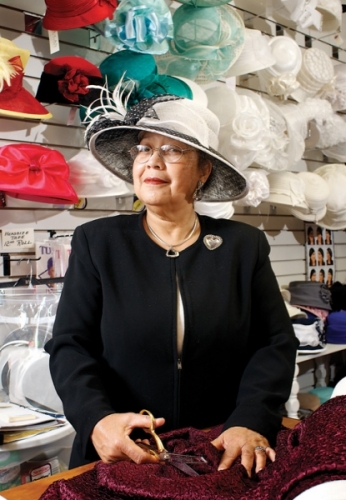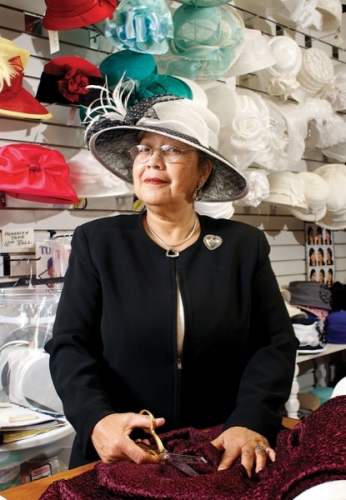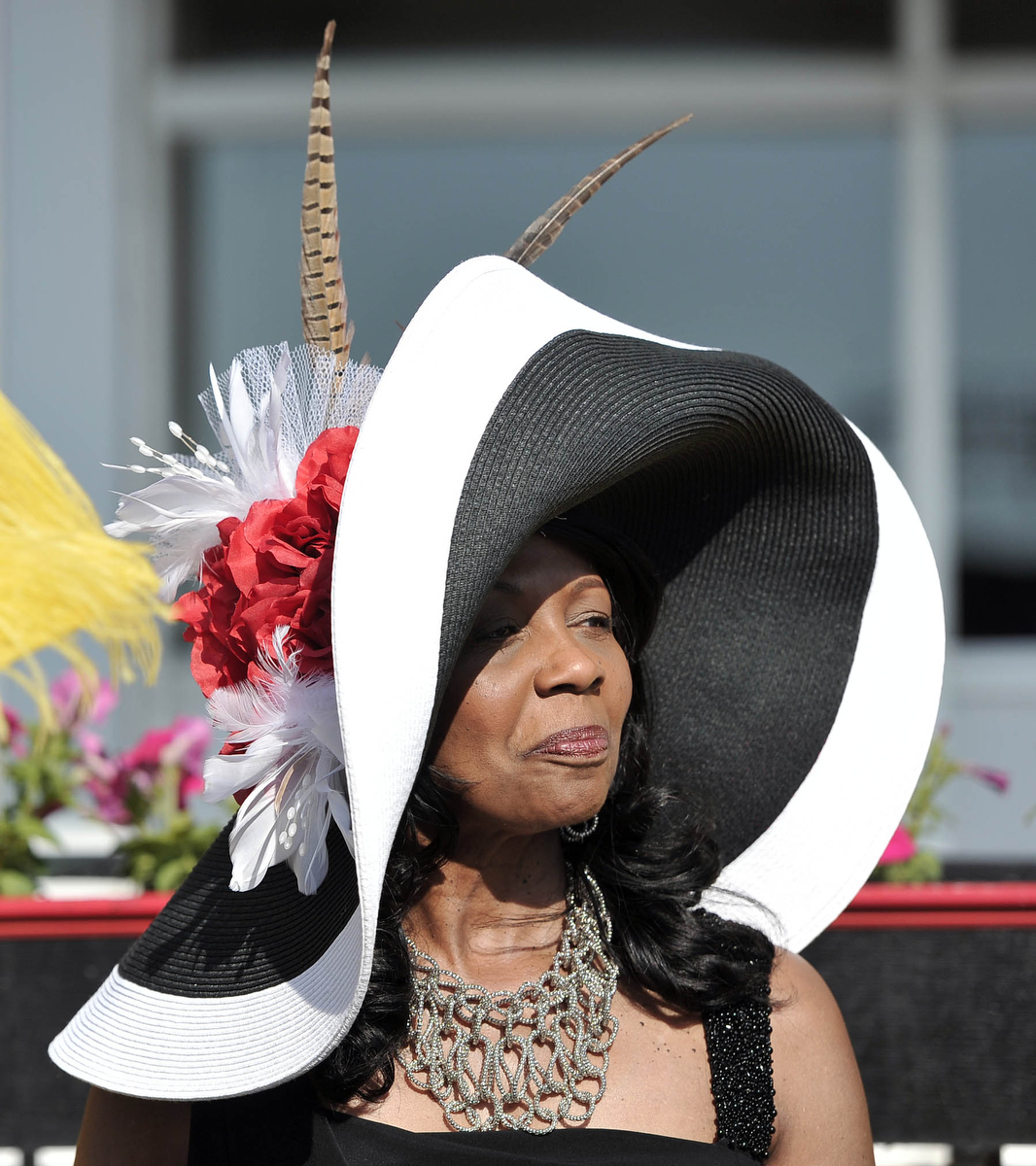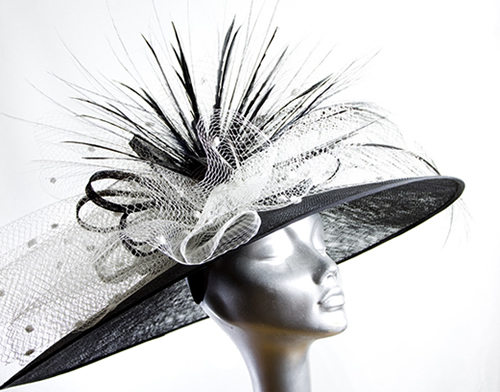
Happy Hump Day POU!
We continue looking at the artistry of Milliners. Today we travel to Baltimore to take a look at the talents of Phyllis Eley.

A hat block stands on a table in front of 68-year-old Phyllis Eley. It’s just a piece of balsa wood, carved in the shape of a woman’s head. But when Eley takes this inanimate object in her hands, it seems to take on life. The block becomes a model, a stand-in for the woman who will wear a Phyllis Eley creation on the top of her head.
Eley, who works out of a shop in Pikesville, is an artist, a maker of women’s hats, also known as a milliner. Millinery isn’t a term used often these days. Its heyday dates back to a time when hats were de rigeur, when a woman without a hat wasn’t completely dressed. These were women who shared Eley’s philosophy, that a “custom-made hat is the ultimate accessory for an outfit.”
That time is long gone, but, every May, the tradition returns to Baltimore. That’s when women join the pageantry of Preakness by donning fabulous headwear.
A milliner cannot make a living on Preakness alone. And these days, most women think of hats as only a special occasion accessory. Yet, Eley is a living reminder that the milliner’s art is not gone. In fact, as Mark Twain might say, rumors of its death are greatly exaggerated.
Although most women today choose not to wear the big fancy hats as their grandmothers and great-grandmothers did in years past. Phyllis Eley says those women just “don’t know what they’re missing.”
Eley was in her early twenties when she discovered her love for hat-making 43 years ago. She enrolled in a class at the Baltimore YWCA and was instructed by two prominent African-American milliners Nell Sheridan and Sophie Myers. They taught Phyllis the basics of the craft, but Eley didn’t stop there. Before long, she taught herself to create all kinds of hats and their trims, entirely by hand. She’s a stickler for detail.

“I’m particular about construction,” she says. “Everything must be securely sewn.”
Back in the ’60s, Eley remembers she bought most of her supplies at a shop on Mulberry Street at American Trimming House owned by Al Schalane, where “a hat block cost $14.”
Today, she says they’re seven times that much. Making hats was not a full-time job for Eley. In fact, it was more like a hobby. She worked for the phone company Bell System for 32 years. “But once I retired,” she says with a smile, “I found my true calling.”
About 18 years ago, Eley was selling her creations at a benefit fashion show when a store owner from Pikesville approached her and asked if she would work for her. There was a large market for hats in Pikesville among the Orthodox Jewish community, whose women keep their heads covered at all times. Eley took the job.
Today, she works at another Pikesville shop called Hats to Hose, and still has an eclectic clientele. Some of her customers are Jewish. Many are African-American. Others just seek her out year-round, especially at Preakness time.

This is an exciting time for Eley because, she says, customers going to the Preakness race are willing to be more daring, and it gives her the chance to be really creative. She says women feel special in their Preakness hats, and “they could feel just as special for other occasions if they would just consider wearing a hat.
In addition to making her own hats, Eley sells and sizes ready-made hats and restores vintage hats. Sometimes customers ask her to completely restyle an older hat.
That is a delicate task. First, Eley carefully pulls the old hat apart, keeping fabric and trim perfectly intact.
She then cuts out a shape for her new hat from buckram (a coarse, stiff cloth), wets the buckram to make it pliable, and molds it onto the hat block. When it dries, it has the shape of the hat-to-be.
Then, with scissors and pins, Eley cuts the fabric and pieces together a little work of art, to be sewn, finished, and presented to the customer.

“That’s the wonderful part,” she says, “when they see it, and love it, and appreciate my work.”
Oh, yes, they appreciate it. Customer Naon Locust calls Eley “a gem, a hidden gem here in Baltimore.”
Customer Dena Soclof agrees. Eley made hats for her for all her daughters’ and granddaughters’ weddings. “Her work is outstanding,” she says.
Hats to Hose co-owner Linda Elman says simply, “I always tell people that Phyllis has golden hands.”
Eley herself is almost never without a hat—usually a custom-made one at that. But young people today, when they do buy hats, tend to buy off the rack. So, what does the future hold for the art of millinery?
The term “milliner” comes from the city of Milan, Italy, where you could find suppliers of fancy goods in the 16th and 17th centuries. Author Debbie Henderson says milliners are coming off the endangered species list. “There’s an amazing resurgence, and there are young men and women going to fashion schools studying millinery,” she says. “There are a lot of new milliners creating exciting styles, especially in Europe.”
There’s no telling when those styles may make it to Baltimore, but, if nothing else, some future milliners may learn their art in Charm City. Annet Couwenberg, a professor at the Maryland Institute College of Art, teaches a class called Fashioning Culture/Readdressing Clothing.
“The first thing I teach in that course is millinery,” she says. “I find it important that students realize the craftsmanship used in traditional millinery techniques. I want them to interpret hats as fine artists.”
So women’s hats, and the talented milliners who make them, live on.
